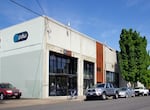
PICA's new building is a 16,000-square-foot complex at NE Hancock and Williams.
Courtesy of PICA
The Portland Institute for Contemporary Art announced Thursday that a patron has bought a 16,000-square-foot compound at 15 NE Hancock St. and offered it to PICA rent-free for 10 years, with an option to extend the lease 10 more.
“We’re moving into a space and not having a capital campaign,” said Ethan Seltzer, PICA’s board president and a professor of urban studies and planning at Portland State University. “This is mind-blowing.”
For 21 years, PICA has been a pied piper of contemporary art, leading audiences into overlooked parts of town, transforming empty warehouses into art hot-spots for events like the Time-Based Art Festival, or TBA, and building a community and an international reputation around creative DIY barn raising.
However, with the real estate market exploding across inner Portland and displacing arts groups across the board, PICA found it increasingly difficult to find affordable venues, particularly for the TBA headquarters known as the Works. It used to be its leaders could make a few phone calls; now, they found themselves spending months searching and still pushing deadlines back when they couldn't secure space until mid-summer.
In recent years, the organization began to question its itinerant model and whether it was time to settle down.
No one thought it would happen this fast.
Located behind the Toyota dealership on the northeast end of the Broadway Bridge, the interconnected complex includes a 10,000-square-foot warehouse, a smaller 3,000-square-foot warehouse, offices, and a retail space that PICA will convert into its public facing Resource Room. Drone footage exclusive to OPB shows the inside of the large warehouse
PICA’s donor in glittering papier-mâché armor is Allie Furlotti, an artist herself, a PICA board member, and the president of the Calligram Foundation, which has contributed significantly to PICA’s programming, as well as subsidized studio space for artists in the Falcon Studios.
“She’s been listening to these strategic conversations and watching the stress on the staff and saying, ‘I think I can solve that,’” said PICA’s executive director, Victoria Frey. “She started looking and found this space on Hancock, and put earnest money down on it and called us and said, ‘Can this work for you?’”
Furlotti found the complex in December, and PICA had a limited time for due diligence. But Frey said it could not have been more perfect: the property had seismic upgrades, storefront improvements, was previously zoned for large assembly to accommodate the public skate park it once housed (as seen in the video, the ramps are still there, though it’s no longer open to the public), and sat at a central point in the city — reachable by car, bike, bus, streetcar, and foot.

The main 10,000-square-foot warehouse will serve as the new Works for PICA's TBA festival, as well as a flex space for programming year round.
Kristan Kennedy / PICA
Normally, finding and renovating new space involves a major capital campaign, and ownership is far from a panacea. Some arts organizations have taken on beautiful new spaces, only to not be able to afford them. Most visibly, the Museum of Contemporary Craft is closing this month because it has never been able to afford its building on the North Park Blocks.
But because of its arrangement with Furlotti, PICA will only be responsible for the overhead costs of operating the property, and as a nonprofit, it is exempt from property tax.
“We’re in a better position now than we are in our current facility with an itinerant program, where we’re building and striking different exhibition spaces in the city,” said Frey.
What will this mean for a roving band of arts mavens who’ve staked their identity on impermanence? Stability, for one things. But also the ability to think long-term and dedicate their resources to expanding their year-round programming.
“It’s a blank canvas,” Frey said of the main space. “You give Angela Mattox, our artistic director, and Kristan Kennedy, our visual arts curator, the opportunity to imagine what that can be, and they’re already spinning with ideas of what artists and projects they want to put in this.”
Frey and Seltzer said that blank canvas can take the shape of a black box for performances, a white box for visual exhibitions, and a bed for collaborations with other arts groups, to say nothing of a place for artists to work and create.
“It’s not so much about envisioning the space as any one thing,” said Seltzer. “It’s not about it being a gallery with white walls and a series of exhibitions that take place once a month on whatever Thursday, as much as this is a place where we see art being made, where we see artists coming together and creating new ideas.”
PICA will get the keys in July and christen the building with TBA in September, although the festival will continue to be citywide. The plan is then build out with Holst Architecture before moving in in early 2017.
“PICA’s role for the last 21 years has been to surprise people, to take the lid off and show folks that their expectations for the city can change — that there’s more possible here than we every thought there was,” Seltzer said.
Now the question is: how will these arts instigators transform a warehouse and a neighborhood, when they don’t have to pack up in the morning?
